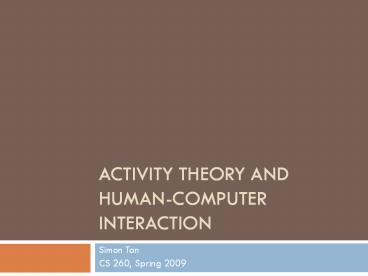Activity Theory and Human-Computer Interaction - PowerPoint PPT Presentation
Title:
Activity Theory and Human-Computer Interaction
Description:
Traditional HCI is based on the application of information ... Many good designers have been oblivious to research. Research work isn't affecting practice ... – PowerPoint PPT presentation
Number of Views:227
Avg rating:3.0/5.0
Title: Activity Theory and Human-Computer Interaction
1
Activity Theory and Human-Computer Interaction
- Simon Tan
- CS 260, Spring 2009
2
History
- The need for Activity Theory
3
The Problem with HCI
- Traditional HCI is based on the application of
information processing cognitive psychology,
which is limited - There exists a startling gap between research
results and practical design - Many good designers have been oblivious to
research - Research work isnt affecting practice
4
The Push for Change
- Criticism of information processing psychology
grew in the 1980s - Recognized a need for consideration of users and
their actual work tasks - By early 1990s, HCI researchers were realizing
- Human actors are more than just cognitive
processors - Studies of individual acts are not practical on
their own - Laboratory experiments lt actual work practices
- Actual use of systems was a long-term process
- Emphasis on design was growing
- Contextuality is important
- A constructive relation between users and systems
existed
5
The Interface at Several Levels
6
Where Activity Theory comes from
- Classical German philosophy
- Emphasized developmental/historical ideas
- Promoted active/constructive role of humans
- Marx and Engels
- Elaborated the concept of activity
- Soviet psychology (Vygotsky, Luria, Leont'ev) in
the 1920s - Paralleled in Deweys pragmatism and G.H. Meads
symbolic interactionism
7
Activity Theory Use
- What is it already??
8
What is Activity Theory?
- A clarifying tool, not a predictive theory
- Offers perspectives on human activity and
concepts for describing that activity - Activity Theory is a philosophical framework for
studying human practices as development processes
9
Critical Features
- Activities are defined as basic units of analysis
- Individual actions meaningful context
Activity - Activities are not static
- Each activity has a history of its own
- Activities are under continuous
change/development - Activities always contain various mediating
artifacts - There is an asymmetry between people and these
artifacts - Notion of consciousness as something directly
related to the conditions current in a persons
situation - Unifies consciousness and activity
10
Structure of an Activity
11
Structure of an Activity
12
Structure of an Activity
Community
13
Levels of an Activity
14
Action-Operation Dynamic
- Before actions are performed, they are planned in
the consciousness with a model (orientation) - Conscious actions ? operations over time
(orientation phase disappears) - New action is created with broader scope,
incorporating new operation - Ex Learning to drive manual
15
Activities are Dynamic
- Activities have both internal and external sides
- Subject transforms object and vice versa
- Subject assimilates the experience of humanity
- Activities are not isolated
- Influence from other activities and environment
- Contradiction is what happens when external
activities / internal components are at odds
16
Role of Information Technology
- In principle, IT can automate all operations
- IT can also support actions
- IT can serve as a tool
- IT can aid sense-making (informate), providing a
new perspective of the object of work - IT can drive communicative actions between
participants - IT can be the principal enabler for activities
- May make an activity feasible
- May allow an object that wouldnt have been
accessible
17
(No Transcript)
18
Contribution of Activity Theory
- With Activity Theory, we can better address
- Issues belonging to different levels within an
integrated framework - Interaction in a social context
- The dynamic features of human practices






























